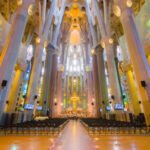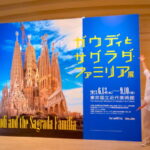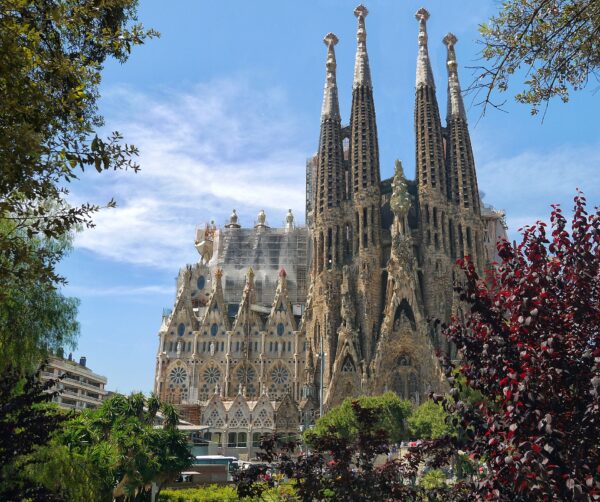
- The Unique Design Elements of Gaudí's Sagrada Familia
- Exploring the Symbolism Behind the Sagrada Familia's Facades
- The Historical Significance of the Sagrada Familia in Barcelona
- How Gaudí's Vision Transformed Modern Architecture
- Visiting the Sagrada Familia: Tips and Insights for Tourists
- The Ongoing Construction of the Sagrada Familia: A Timeline of Progress
The Sagrada Familia, an iconic basilica in Barcelona, stands as a testament to the genius of architect Antoni Gaudí. Its intricate designs and innovative structures reflect a unique blend of Gothic and Art Nouveau styles, captivating millions of visitors each year.
Often referred to as The Marvelous Architecture: The Sagrada Familia in Barcelona Designed by Gaudí, this architectural masterpiece is a symbol of the city's cultural heritage. As construction continues, it remains a work in progress, embodying the vision and passion that Gaudí poured into his life's work.
The Unique Design Elements of Gaudí's Sagrada Familia
One of the most striking unique design elements of Gaudí's Sagrada Familia is its use of natural forms. Inspired by the shapes found in nature, Gaudí incorporated organic motifs into the basilica's architecture. Features such as columns resembling tree trunks, branches extending into the ceiling, and facades that mimic geological formations create a harmonious relationship with the surrounding environment. This integration of nature into architecture is a hallmark of Gaudí’s artistic philosophy.
Another remarkable aspect is the innovative use of light within the Sagrada Familia. Gaudí designed the basilica to capture and filter sunlight through stained glass windows, creating a kaleidoscope of colors that transform the interior space throughout the day. The arrangement of these windows is intentional, with different hues symbolizing various aspects of the divine and enhancing the spiritual atmosphere of the basilica. Each section of the church receives unique lighting, adding to its mystical allure.
The structural engineering of the Sagrada Familia is also unparalleled. Gaudí employed a technique known as hyperbolic paraboloids to create complex shapes that distribute weight efficiently, allowing for taller and more intricate designs. This approach not only challenged conventional architectural norms but also paved the way for modern construction techniques. The interplay of stability and beauty is evident in every arch and spire, showcasing Gaudí's forward-thinking vision.
In addition to these elements, the Sagrada Familia features a rich array of symbolism. Each facade tells a story, with intricate sculptures depicting biblical narratives and spiritual themes. The Nativity Facade, for instance, celebrates the birth of Jesus through its detailed carvings of flora and fauna, emphasizing the connection between religion and nature. The artistic storytelling woven through the architecture invites visitors to explore the deeper meanings behind Gaudí’s design choices.
Exploring the Symbolism Behind the Sagrada Familia's Facades
The Sagrada Familia's facades are rich in symbolism, each narrating a distinct chapter of the Christian faith. The Passion Facade, stark and angular, portrays the suffering of Christ through its dramatic sculptures. This facade contrasts sharply with the Nativity Facade, which is overflowing with life and joy, depicting the birth of Jesus surrounded by intricate carvings of nature, symbolizing the harmony between spirituality and the natural world.
Moreover, the Glory Facade, which remains unfinished, aims to convey the glory of Jesus through representations of the Last Judgment. It incorporates elements such as angels, saints, and the Tree of Life, emphasizing the connection between heaven and earth. This facade invites contemplation, creating a pathway for visitors to reflect on their own spiritual journeys and the nature of divine glory.
Another aspect of the facades is their use of natural motifs that resonate with Gaudí's philosophy. The intricate detailing found in the sculptural work reflects the flora and fauna of the region, creating a dialogue between the architecture and its surrounding environment. This approach not only enhances the visual appeal but also reinforces the idea of the divine presence within nature, making each visit a profound experience.
In summary, exploring the symbolism behind the Sagrada Familia's facades reveals a complex interplay of faith and nature. The distinct stories told through each facade contribute to the overall narrative of Gaudí's masterpiece, inviting visitors to engage with its spiritual essence. This seamless blend of art and theology makes the Sagrada Familia a unique pilgrimage site for those seeking deeper understanding.
The Historical Significance of the Sagrada Familia in Barcelona
The historical significance of the Sagrada Familia goes beyond its architectural brilliance; it represents a cultural and spiritual icon for Barcelona. Designed by Antoni Gaudí in the late 19th century, this basilica has become a symbol of the city's identity and a testament to its artistic legacy. The ongoing construction underscores the dedication of the community to preserve Gaudí's vision, allowing the basilica to evolve while remaining true to its original purpose.
Throughout its history, the Sagrada Familia has been a site of pilgrimage and reflection, attracting millions of visitors annually. Its blend of religious and artistic expression has made it a focal point for cultural activities and spiritual gatherings. Key historical aspects include:
- The foundation stone was laid in 1882, marking the beginning of a grand vision.
- In 1926, Gaudí's untimely death left the project unfinished, yet it continued under the guidance of his disciples.
- The basilica was declared a UNESCO World Heritage Site in 2005, recognizing its global cultural significance.
Moreover, the Sagrada Familia reflects the socio-political changes in Spain over the decades. Its construction was initially funded by private donations, representing a communal effort to build a sacred space. This aspect highlights Barcelona's commitment to preserving its cultural heritage in the face of modernity and change. The basilica stands as a reminder of the city's resilience and dedication to art and spirituality.
In summary, the Sagrada Familia serves not only as a remarkable architectural feat but also as a living historical document. It embodies the spirit of Barcelona, encompassing themes of faith, community, and artistic innovation. As construction progresses, it continues to forge a connection between the past and the future, ensuring its place in the hearts and minds of all who experience its grandeur.
How Gaudí's Vision Transformed Modern Architecture
Antoni Gaudí's vision has profoundly reshaped the landscape of modern architecture, introducing a distinctive fusion of form and function that challenges conventional design principles. His approach transcended mere aesthetics, incorporating natural elements and innovative structural techniques that have influenced countless architects worldwide. Gaudí's work, particularly the Sagrada Familia, epitomizes how architecture can become a living organism, responding fluidly to its environment.
One of the most revolutionary aspects of Gaudí's design philosophy is his emphasis on organic shapes derived from nature. By using forms such as parabolic curves and hyperbolic structures, he created buildings that not only stand out visually but also possess a sense of harmony with the surrounding landscape. This approach laid the groundwork for what would later be recognized as biomorphic architecture, inspiring a new generation of architects to explore the integration of nature into urban environments.
Moreover, Gaudí's pioneering use of light and color has transformed how spaces are experienced. Through strategically placed stained glass and carefully designed openings, he manipulated light to evoke emotions and enhance the spiritual essence of a space. This technique has encouraged modern architects to consider the emotional impact of light in their designs, making it a crucial element in contemporary architecture.
Ultimately, Gaudí's legacy is not merely his iconic buildings like the Sagrada Familia but also his profound influence on architectural theory and practice. His commitment to innovation and the celebration of cultural identity have inspired a global movement towards more sustainable and context-specific architecture. As we continue to build for the future, Gaudí's visionary principles serve as a guiding light for architects seeking to create spaces that resonate with both people and the environment.
Visiting the Sagrada Familia: Tips and Insights for Tourists
When visiting the Sagrada Familia, planning is key to making the most of your experience. It's advisable to book tickets online in advance to avoid long queues, especially during peak tourist seasons. Consider choosing a guided tour, which can provide deeper insights into Gaudí's vision and the basilica's intricate details. Early morning or late afternoon visits often offer a quieter atmosphere and stunning lighting for photography.
Another tip is to explore the surrounding area of the Sagrada Familia. The neighborhood is rich in restaurants, shops, and parks, providing a perfect opportunity to enjoy local cuisine or take a leisurely stroll after your visit. Don't forget to admire the different viewpoints around the basilica, where you can capture its grandeur from various angles, showcasing Gaudí's architectural genius.
While touring, pay attention to the stained glass windows and how they transform the interior space with colorful light. Each window tells a story and enhances the spiritual ambiance of the basilica. Additionally, take time to appreciate the facades, as each one reflects different aspects of the Christian narrative and Gaudí's artistic philosophy, making every detail worth exploring.
Lastly, consider visiting the Sagrada Familia on weekdays rather than weekends to avoid larger crowds. Utilizing audio guides or mobile apps can also enrich your understanding of the basilica’s history and symbolism. Remember to dress appropriately, as it is a place of worship, and maintain a respectful demeanor while inside. Enjoy your journey through this architectural marvel!
The Ongoing Construction of the Sagrada Familia: A Timeline of Progress
The ongoing construction of the Sagrada Familia represents a remarkable journey through time, reflecting both the evolution of architectural techniques and the enduring vision of Antoni Gaudí. Begun in 1882, the project has seen various phases of development, influenced by historical events and technological advancements. The anticipated completion date, initially projected for 2026 to coincide with the centenary of Gaudí's death, has now been extended, demonstrating the complexity and ambition of this monumental task.
Significant milestones in the construction timeline include:
- 1882: Foundation stone laid, marking the start of Gaudí's grand vision.
- 1926: Gaudí's tragic death results in the project being left unfinished, yet it perseveres under the guidance of his followers.
- 2010: The basilica is consecrated by Pope Benedict XVI, elevating its status as a place of worship.
- 2020: The COVID-19 pandemic causes temporary halts, but construction resumes with enhanced safety measures.
As construction progresses, advancements in technology play a pivotal role in realizing Gaudí's original designs. Innovative tools and methods, including computer-aided design, have enabled architects and craftsmen to replicate and interpret the intricate details of Gaudí’s vision with greater precision. The use of sustainable materials and practices also reflects a commitment to modern environmental standards, ensuring that the Sagrada Familia remains a beacon of architectural brilliance.
Ultimately, the ongoing construction of the Sagrada Familia is not merely an architectural endeavor but a testament to the collaborative spirit of the global community. As artisans, engineers, and volunteers work together, the basilica stands as a symbol of shared purpose and artistic dedication, bridging the past with the future while perpetually captivating those who encounter its breathtaking beauty.
 Exploring the Depths of Sagrada Familia Barcelona: Unveiling its Magnificent Interior | 94
Exploring the Depths of Sagrada Familia Barcelona: Unveiling its Magnificent Interior | 94 Discover the Marvels of Sagrada Familia in Barcelona!
Discover the Marvels of Sagrada Familia in Barcelona!If you want to know other articles similar to The Marvelous Architecture: The Sagrada Familia in Barcelona Designed by Gaudí you can visit the category WHERE YOU CAN GO.
Deja una respuesta










Read more!